Comprehensive Report on Corporate Accounting and Lease Reporting
VerifiedAdded on 2021/06/16
|5
|1255
|19
Report
AI Summary
This report provides a detailed analysis of corporate accounting and reporting, specifically focusing on lease accounting. It begins by defining leases, differentiating between financial and operating leases, and outlining the roles of lessors and lessees. The report then delves into the accounting treatment for financial leases from the lessee's perspective, detailing the valuation of the right-of-use asset and lease liability, including considerations for initial measurement, subsequent measurement, and depreciation. It covers the components used in calculating the value of the right-of-use asset, including lease payments, and the subsequent adjustments required. Furthermore, the report addresses the presentation of lease-related information in financial statements, including the balance sheet, income statement, and cash flow statement, and emphasizes the importance of disclosures to ensure transparency and aid users in understanding the impact of leases. The document is designed to provide a comprehensive understanding of lease accounting principles and their application in corporate financial reporting.
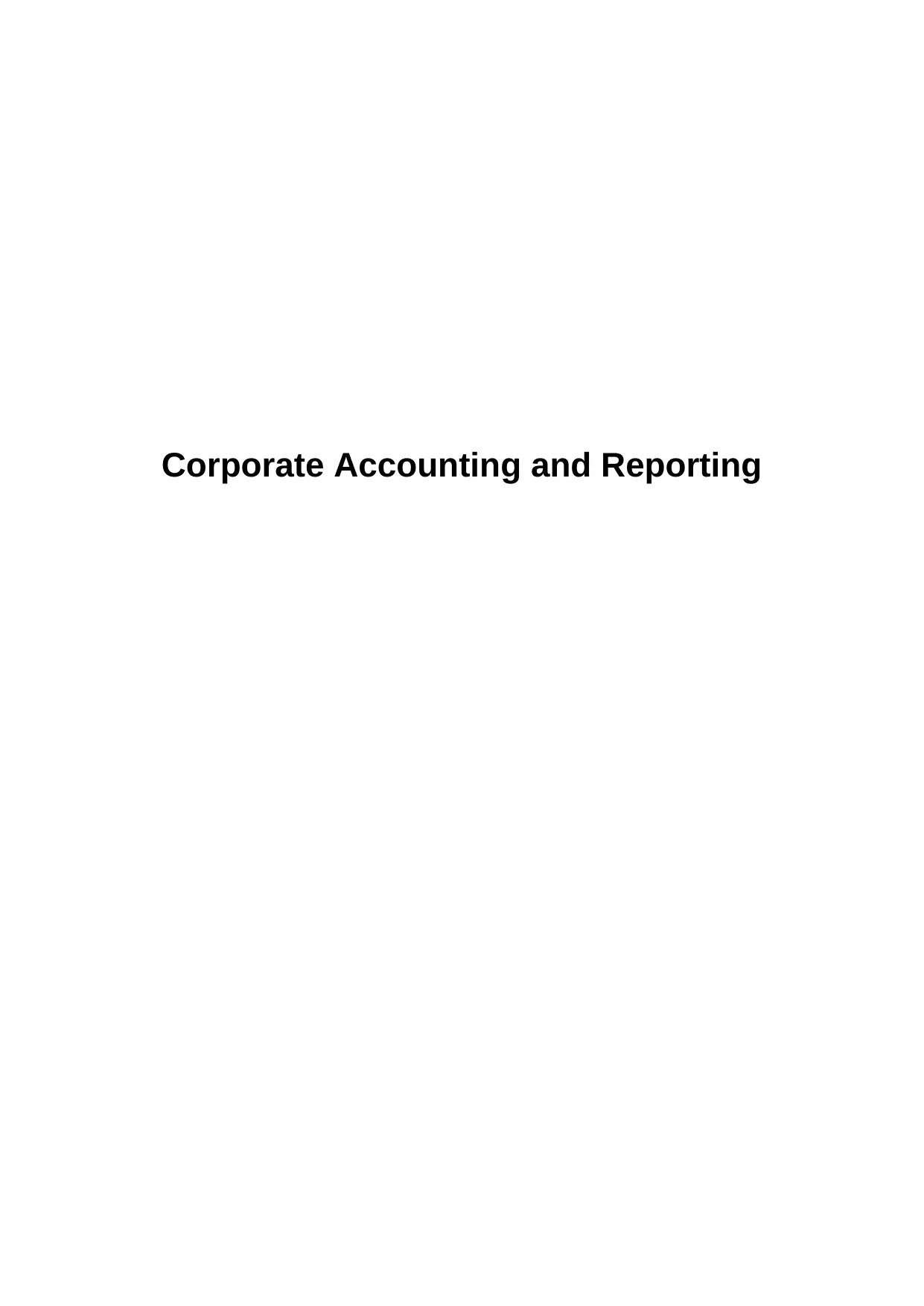
Corporate Accounting and Reporting
Paraphrase This Document
Need a fresh take? Get an instant paraphrase of this document with our AI Paraphraser
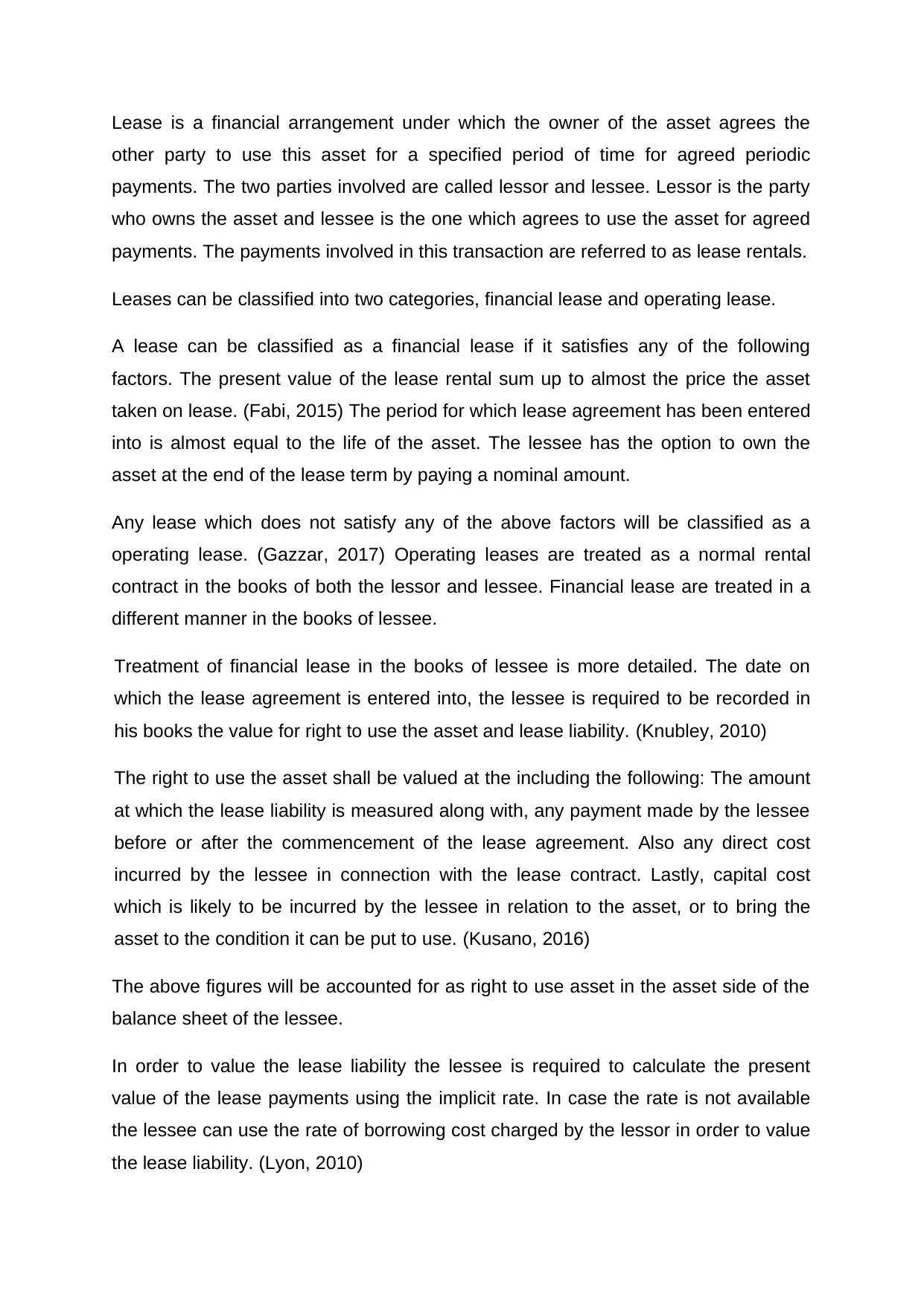
Lease is a financial arrangement under which the owner of the asset agrees the
other party to use this asset for a specified period of time for agreed periodic
payments. The two parties involved are called lessor and lessee. Lessor is the party
who owns the asset and lessee is the one which agrees to use the asset for agreed
payments. The payments involved in this transaction are referred to as lease rentals.
Leases can be classified into two categories, financial lease and operating lease.
A lease can be classified as a financial lease if it satisfies any of the following
factors. The present value of the lease rental sum up to almost the price the asset
taken on lease. (Fabi, 2015) The period for which lease agreement has been entered
into is almost equal to the life of the asset. The lessee has the option to own the
asset at the end of the lease term by paying a nominal amount.
Any lease which does not satisfy any of the above factors will be classified as a
operating lease. (Gazzar, 2017) Operating leases are treated as a normal rental
contract in the books of both the lessor and lessee. Financial lease are treated in a
different manner in the books of lessee.
Treatment of financial lease in the books of lessee is more detailed. The date on
which the lease agreement is entered into, the lessee is required to be recorded in
his books the value for right to use the asset and lease liability. (Knubley, 2010)
The right to use the asset shall be valued at the including the following: The amount
at which the lease liability is measured along with, any payment made by the lessee
before or after the commencement of the lease agreement. Also any direct cost
incurred by the lessee in connection with the lease contract. Lastly, capital cost
which is likely to be incurred by the lessee in relation to the asset, or to bring the
asset to the condition it can be put to use. (Kusano, 2016)
The above figures will be accounted for as right to use asset in the asset side of the
balance sheet of the lessee.
In order to value the lease liability the lessee is required to calculate the present
value of the lease payments using the implicit rate. In case the rate is not available
the lessee can use the rate of borrowing cost charged by the lessor in order to value
the lease liability. (Lyon, 2010)
other party to use this asset for a specified period of time for agreed periodic
payments. The two parties involved are called lessor and lessee. Lessor is the party
who owns the asset and lessee is the one which agrees to use the asset for agreed
payments. The payments involved in this transaction are referred to as lease rentals.
Leases can be classified into two categories, financial lease and operating lease.
A lease can be classified as a financial lease if it satisfies any of the following
factors. The present value of the lease rental sum up to almost the price the asset
taken on lease. (Fabi, 2015) The period for which lease agreement has been entered
into is almost equal to the life of the asset. The lessee has the option to own the
asset at the end of the lease term by paying a nominal amount.
Any lease which does not satisfy any of the above factors will be classified as a
operating lease. (Gazzar, 2017) Operating leases are treated as a normal rental
contract in the books of both the lessor and lessee. Financial lease are treated in a
different manner in the books of lessee.
Treatment of financial lease in the books of lessee is more detailed. The date on
which the lease agreement is entered into, the lessee is required to be recorded in
his books the value for right to use the asset and lease liability. (Knubley, 2010)
The right to use the asset shall be valued at the including the following: The amount
at which the lease liability is measured along with, any payment made by the lessee
before or after the commencement of the lease agreement. Also any direct cost
incurred by the lessee in connection with the lease contract. Lastly, capital cost
which is likely to be incurred by the lessee in relation to the asset, or to bring the
asset to the condition it can be put to use. (Kusano, 2016)
The above figures will be accounted for as right to use asset in the asset side of the
balance sheet of the lessee.
In order to value the lease liability the lessee is required to calculate the present
value of the lease payments using the implicit rate. In case the rate is not available
the lessee can use the rate of borrowing cost charged by the lessor in order to value
the lease liability. (Lyon, 2010)
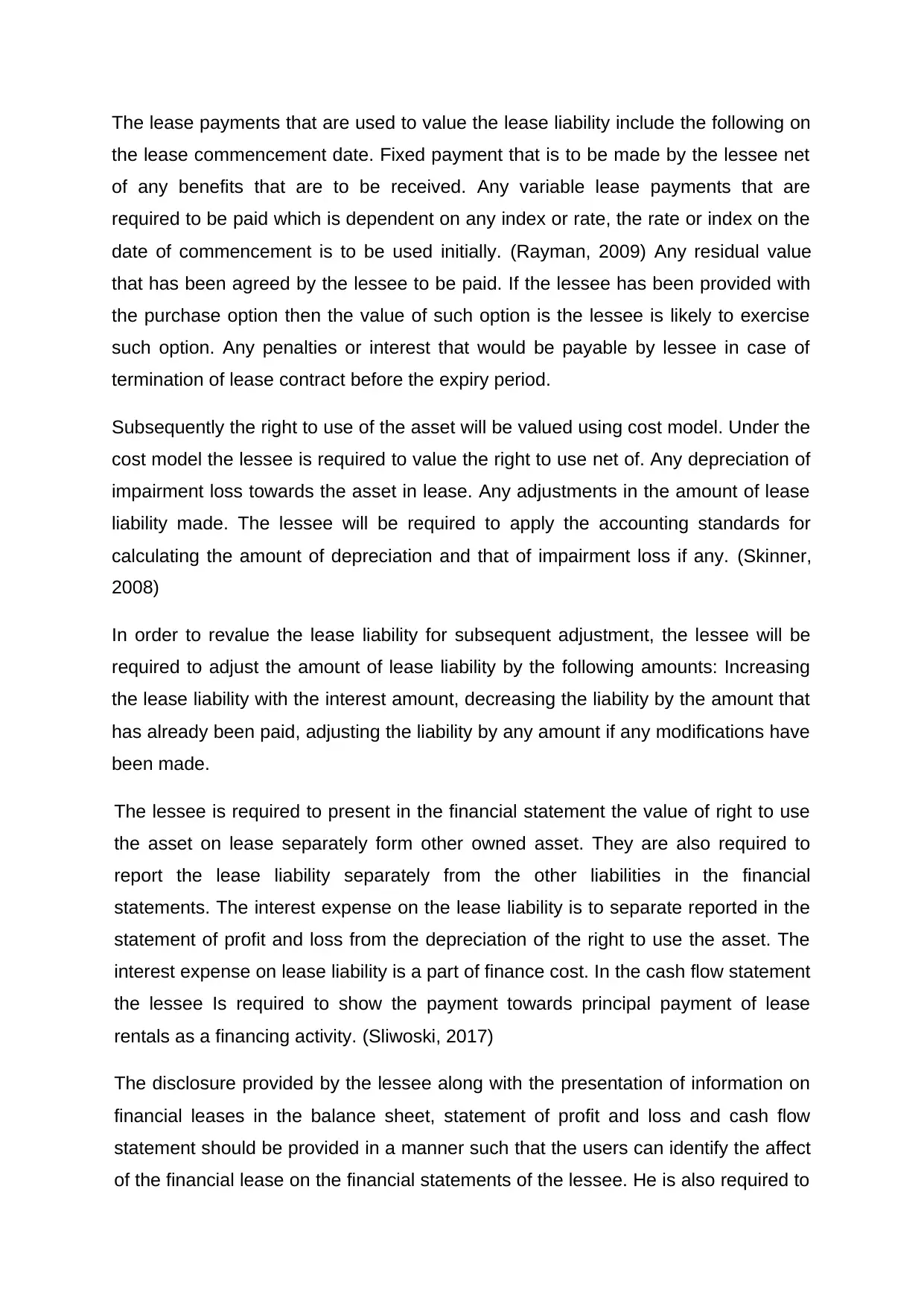
The lease payments that are used to value the lease liability include the following on
the lease commencement date. Fixed payment that is to be made by the lessee net
of any benefits that are to be received. Any variable lease payments that are
required to be paid which is dependent on any index or rate, the rate or index on the
date of commencement is to be used initially. (Rayman, 2009) Any residual value
that has been agreed by the lessee to be paid. If the lessee has been provided with
the purchase option then the value of such option is the lessee is likely to exercise
such option. Any penalties or interest that would be payable by lessee in case of
termination of lease contract before the expiry period.
Subsequently the right to use of the asset will be valued using cost model. Under the
cost model the lessee is required to value the right to use net of. Any depreciation of
impairment loss towards the asset in lease. Any adjustments in the amount of lease
liability made. The lessee will be required to apply the accounting standards for
calculating the amount of depreciation and that of impairment loss if any. (Skinner,
2008)
In order to revalue the lease liability for subsequent adjustment, the lessee will be
required to adjust the amount of lease liability by the following amounts: Increasing
the lease liability with the interest amount, decreasing the liability by the amount that
has already been paid, adjusting the liability by any amount if any modifications have
been made.
The lessee is required to present in the financial statement the value of right to use
the asset on lease separately form other owned asset. They are also required to
report the lease liability separately from the other liabilities in the financial
statements. The interest expense on the lease liability is to separate reported in the
statement of profit and loss from the depreciation of the right to use the asset. The
interest expense on lease liability is a part of finance cost. In the cash flow statement
the lessee Is required to show the payment towards principal payment of lease
rentals as a financing activity. (Sliwoski, 2017)
The disclosure provided by the lessee along with the presentation of information on
financial leases in the balance sheet, statement of profit and loss and cash flow
statement should be provided in a manner such that the users can identify the affect
of the financial lease on the financial statements of the lessee. He is also required to
the lease commencement date. Fixed payment that is to be made by the lessee net
of any benefits that are to be received. Any variable lease payments that are
required to be paid which is dependent on any index or rate, the rate or index on the
date of commencement is to be used initially. (Rayman, 2009) Any residual value
that has been agreed by the lessee to be paid. If the lessee has been provided with
the purchase option then the value of such option is the lessee is likely to exercise
such option. Any penalties or interest that would be payable by lessee in case of
termination of lease contract before the expiry period.
Subsequently the right to use of the asset will be valued using cost model. Under the
cost model the lessee is required to value the right to use net of. Any depreciation of
impairment loss towards the asset in lease. Any adjustments in the amount of lease
liability made. The lessee will be required to apply the accounting standards for
calculating the amount of depreciation and that of impairment loss if any. (Skinner,
2008)
In order to revalue the lease liability for subsequent adjustment, the lessee will be
required to adjust the amount of lease liability by the following amounts: Increasing
the lease liability with the interest amount, decreasing the liability by the amount that
has already been paid, adjusting the liability by any amount if any modifications have
been made.
The lessee is required to present in the financial statement the value of right to use
the asset on lease separately form other owned asset. They are also required to
report the lease liability separately from the other liabilities in the financial
statements. The interest expense on the lease liability is to separate reported in the
statement of profit and loss from the depreciation of the right to use the asset. The
interest expense on lease liability is a part of finance cost. In the cash flow statement
the lessee Is required to show the payment towards principal payment of lease
rentals as a financing activity. (Sliwoski, 2017)
The disclosure provided by the lessee along with the presentation of information on
financial leases in the balance sheet, statement of profit and loss and cash flow
statement should be provided in a manner such that the users can identify the affect
of the financial lease on the financial statements of the lessee. He is also required to
⊘ This is a preview!⊘
Do you want full access?
Subscribe today to unlock all pages.

Trusted by 1+ million students worldwide
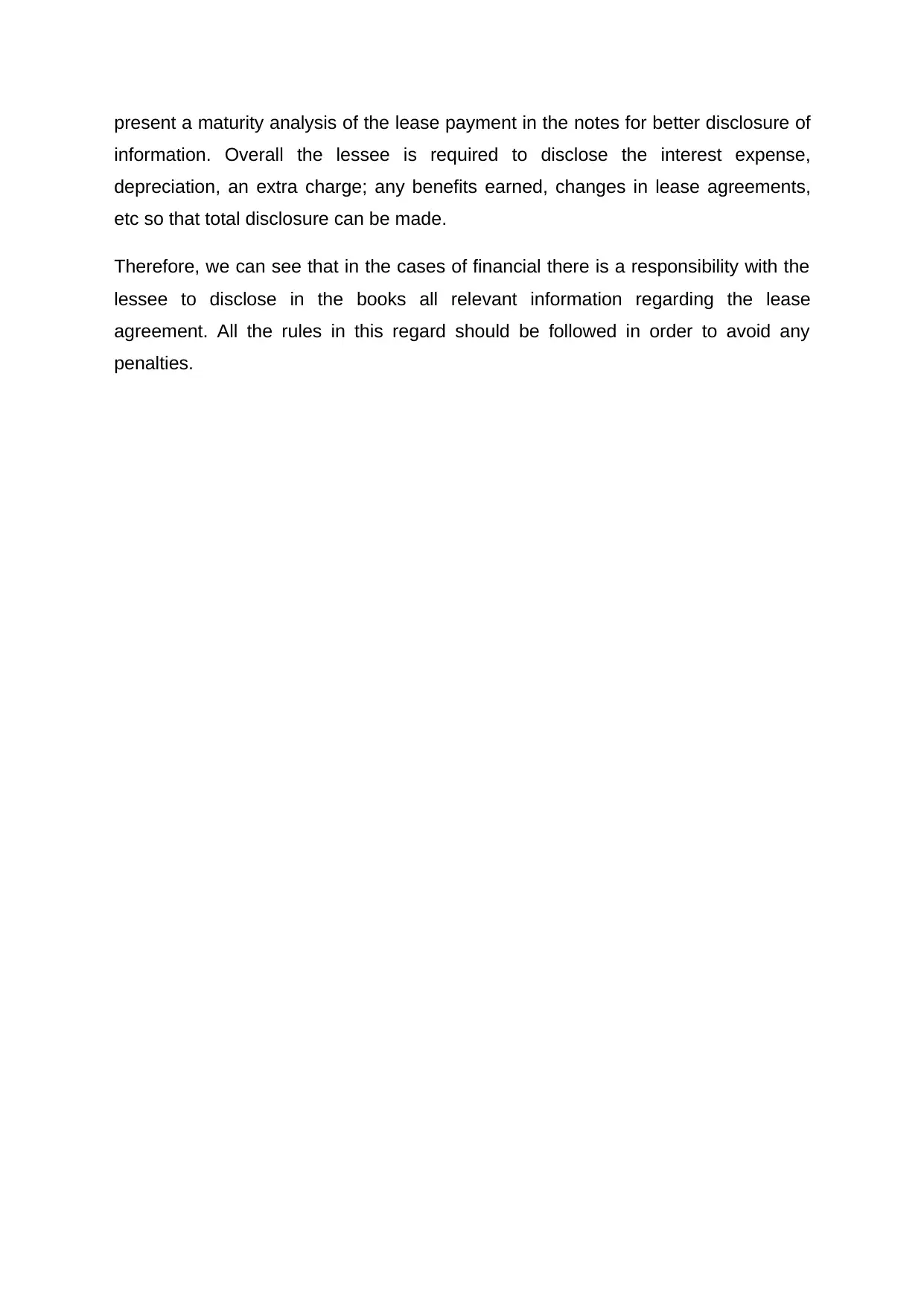
present a maturity analysis of the lease payment in the notes for better disclosure of
information. Overall the lessee is required to disclose the interest expense,
depreciation, an extra charge; any benefits earned, changes in lease agreements,
etc so that total disclosure can be made.
Therefore, we can see that in the cases of financial there is a responsibility with the
lessee to disclose in the books all relevant information regarding the lease
agreement. All the rules in this regard should be followed in order to avoid any
penalties.
information. Overall the lessee is required to disclose the interest expense,
depreciation, an extra charge; any benefits earned, changes in lease agreements,
etc so that total disclosure can be made.
Therefore, we can see that in the cases of financial there is a responsibility with the
lessee to disclose in the books all relevant information regarding the lease
agreement. All the rules in this regard should be followed in order to avoid any
penalties.
Paraphrase This Document
Need a fresh take? Get an instant paraphrase of this document with our AI Paraphraser
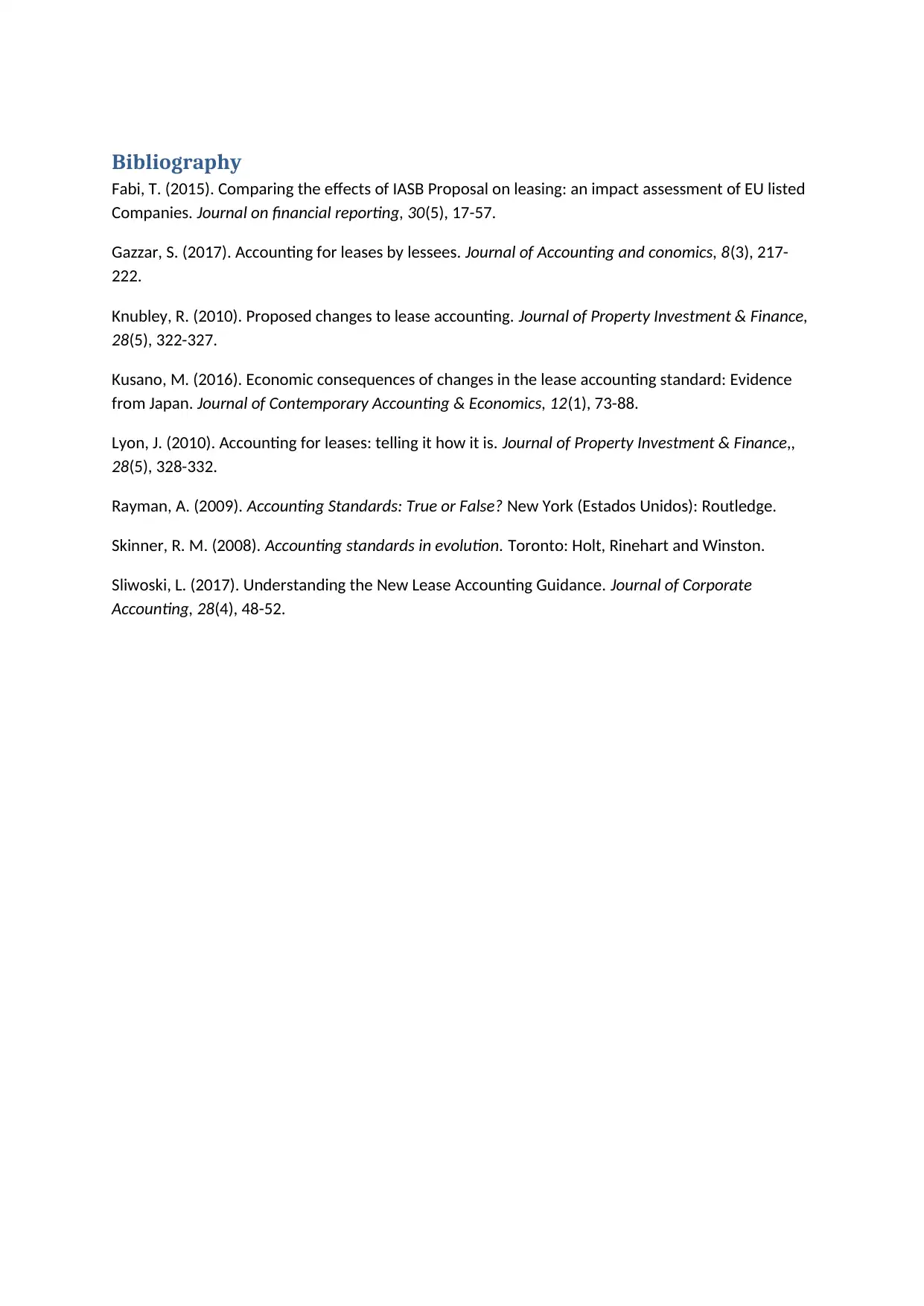
Bibliography
Fabi, T. (2015). Comparing the effects of IASB Proposal on leasing: an impact assessment of EU listed
Companies. Journal on financial reporting, 30(5), 17-57.
Gazzar, S. (2017). Accounting for leases by lessees. Journal of Accounting and conomics, 8(3), 217-
222.
Knubley, R. (2010). Proposed changes to lease accounting. Journal of Property Investment & Finance,
28(5), 322-327.
Kusano, M. (2016). Economic consequences of changes in the lease accounting standard: Evidence
from Japan. Journal of Contemporary Accounting & Economics, 12(1), 73-88.
Lyon, J. (2010). Accounting for leases: telling it how it is. Journal of Property Investment & Finance,,
28(5), 328-332.
Rayman, A. (2009). Accounting Standards: True or False? New York (Estados Unidos): Routledge.
Skinner, R. M. (2008). Accounting standards in evolution. Toronto: Holt, Rinehart and Winston.
Sliwoski, L. (2017). Understanding the New Lease Accounting Guidance. Journal of Corporate
Accounting, 28(4), 48-52.
Fabi, T. (2015). Comparing the effects of IASB Proposal on leasing: an impact assessment of EU listed
Companies. Journal on financial reporting, 30(5), 17-57.
Gazzar, S. (2017). Accounting for leases by lessees. Journal of Accounting and conomics, 8(3), 217-
222.
Knubley, R. (2010). Proposed changes to lease accounting. Journal of Property Investment & Finance,
28(5), 322-327.
Kusano, M. (2016). Economic consequences of changes in the lease accounting standard: Evidence
from Japan. Journal of Contemporary Accounting & Economics, 12(1), 73-88.
Lyon, J. (2010). Accounting for leases: telling it how it is. Journal of Property Investment & Finance,,
28(5), 328-332.
Rayman, A. (2009). Accounting Standards: True or False? New York (Estados Unidos): Routledge.
Skinner, R. M. (2008). Accounting standards in evolution. Toronto: Holt, Rinehart and Winston.
Sliwoski, L. (2017). Understanding the New Lease Accounting Guidance. Journal of Corporate
Accounting, 28(4), 48-52.
1 out of 5
Related Documents
Your All-in-One AI-Powered Toolkit for Academic Success.
+13062052269
info@desklib.com
Available 24*7 on WhatsApp / Email
![[object Object]](/_next/static/media/star-bottom.7253800d.svg)
Unlock your academic potential
Copyright © 2020–2025 A2Z Services. All Rights Reserved. Developed and managed by ZUCOL.





